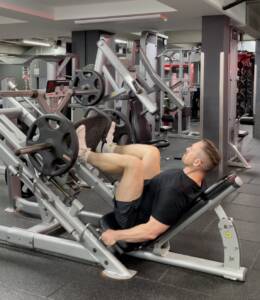
The leg press gets a lot of flack in the fitness community. Most folks concede that it’s a solid tool for isolating the leg muscles (mainly the quads), but, beyond hypertrophy, it’s just a cop-out for folks who can’t or don’t want to squat. This sentiment is false, and you may be missing out on worthwhile strength and muscle-building benefits.
It Doesn’t Require Balance
Part of the reason the leg press gets so much hate (presumably) is the simplicity of the exercise. It’s almost seen as a lazy persons’ squat since you’re either sitting or supine during your reps. However, it’s the ease of use that, in part, makes the leg press such an effective movement.
For those who may struggle with balance, the leg press can be a good option to build leg muscles. The leg press machine assists with balance since you are in a seated position versus standing in a squat. Beginner lifters may lose balance when squatting due to issues with mobility , flexibility, or underdeveloped muscles.
While squats may be beneficial for practicing balance, they can also be ineffective and potentially dangerous if done improperly.
You Can Move a Lot of Weight
Most people can tolerate a pretty high volume of work in a leg press, as the quads do get a lot of exercise even in daily life, and there’s relatively little load on the back and core. The stability needed in a squat relies on your core and spine, whereas with the leg press, the stability is coming mostly from the machine. Therefore, a lifter can typically push heavier weights than they would a squat.
It should be noted that too much weight, as with any exercise, can lead to injury. Even though you can typically go heavier with this exercise, if you feel your back rounding, that’s a sign the weight is most likely too heavy.
It’s Beginner-Friendly
The leg press requires proper form, but it is not as complex as the squat, making it more beginner friendly . Machines in general can be advantageous for beginners due to the greater stability provided and the assistance with form. The leg press can provide more stability to the spine and the core, which are two extremely important areas to remain stable when lifting.
If these areas are not stabilized, inefficient exercise and injury may occur. Lastly, the leg press may seem less intimidating than a barbell at first and is a great place to start.
It Isolates the Legs
The leg press has you lay back on to a pad (or sit on a seat) and drive the weight using only your legs. Your upper body isn’t involved in the movement at all, which is especially helpful if you’re dealing with a nagging shoulder or elbow injury.
